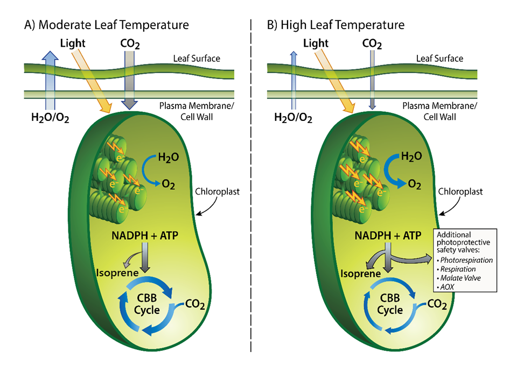The Science
The increase in global temperature directly affects the net primary productivity of the forest. High temperatures can influence the rates of chemical reactions in cells, such as photosynthesis, electron transport and isoprene emissions. In this study, we asked the following research questions:
1) Are reductions in photosynthesis at high leaf temperatures in tropical forests linked to a reduction in stomatal conductance (gs) rather than direct negative temperature effects on photosynthesis?
2) Do current isoprene emission models that link photosynthetic electron transport rates to isoprene emissions rates as a function of temperature hold true in tropical species?
3) What is the role of isoprene on thermal tolerance of photosynthesis at high temperatures?
We discovered that in a “thermophile” early successional species in the Amazon, photosynthetic electron transport rates increased linearly with temperature in concert with isoprene emissions, even as stomatal conductance and net photosynthetic carbon fixation declined. We observed the highest temperatures of continually increasing isoprene emissions yet reported and that blocking isoprene production induced a temperature-dependent loss of photosynthetic capacity.
The Impact
Tropical forests absorb large amounts of atmospheric CO2, but substantial decreases in tropical forest gross primary productivity have been repeatedly demonstrated in the Amazon basin during periodic widespread drought associated with high temperature. Therefore, the physiological mechanisms through which tropical forests respond to high temperature are critically important to understand. While extreme warming will decrease stomatal conductance and net photosynthesis in tropical species, our observations support a thermal tolerance mechanism where the maintenance of high photosynthetic capacity under extreme warming is assisted by the simultaneous stimulation of photosynthetic electron transport (ETR) and metabolic pathways that consume the direct products of ETR including photorespiration and the biosynthesis of thermoprotective isoprenoids. Our results demonstrate that models which link isoprene emissions to the rate of ETR are ideal for tropical species and provide necessary “ground-truthing” for simulations of the large predicted increases in tropical isoprene emissions with climate warming.
Summary
Tropical forests absorb large amounts of atmospheric CO2 through photosynthesis, but high surface temperatures suppress this absorption while promoting isoprene emissions. While mechanistic isoprene emission models predict a tight coupling to ETR as a function of temperature, direct field observations of these phenomena are lacking in the tropics and are necessary to assess the impact of a warming climate on global isoprene emissions. Here, we demonstrate that in the early successional species Vismia guianensis in the central Amazon, ETR rates increased with temperature in concert with isoprene emissions, even as gs and net photosynthetic carbon fixation (Pn) declined. We observed the highest temperatures of continually increasing isoprene emissions yet reported (50°C). While Pn showed an optimum value of 32.6 ± 0.4°C, isoprene emissions, ETR, and the oxidation state of PSII reaction centers (qL) increased with leaf temperature with strong linear correlations for ETR (ƿ = 0.98) and qL (ƿ = 0.99) with leaf isoprene emissions. In contrast, other photoprotective mechanisms, such as non-photochemical quenching (NPQ), were not activated at elevated temperatures. Inhibition of isoprenoid biosynthesis repressed Pn at high temperatures through a mechanism that was independent of stomatal closure. While extreme warming will decrease gs and Pn in tropical species, our observations support a thermal tolerance mechanism where the maintenance of high photosynthetic capacity under extreme warming is assisted by the simultaneous stimulation of ETR and metabolic pathways that consume the direct products of ETR including photorespiration and the biosynthesis of thermoprotective isoprenoids. Our results confirm that models which link isoprene emissions to the rate of ETR hold true in tropical species and provide necessary “ground-truthing” for simulations of the large predicted increases in tropical isoprene emissions with climate warming.


Figure 1. Proposed biochemical model of the acclimation to high temperature stress through the consumption of photosynthetic energy (ATP) and reducing equivalents (NADPH) through the activation of the isoprenoid pathway together in parallel with other coupled biochemical pathways (adapted from Voss et al., 2013 and Morfopoulos et al., 2014). O2: oxygen; CO2: carbon dioxide; H2O: water; ATP: adenosine triphosphate; NADPH: Nicotinamide-Adenine-Dinucleotide-Phosphate; AOX: alternative oxidases of mitochondria.
Figure 2. Graphical representation the influence of proposed surface temperature impacts on plant physiological processes influencing terrestrial ecosystem carbon cycling from leaf to global scales. NPP: Net Primary Productivity, Gs: Stomatal Conductance, ETR: Electron Transport Rate, qL: Fraction of PSII centers that are oxidized, CO2: carbon dioxide.
PI Contact: Kolby Jardine, Earth and Environmental Sciences Area, Lawrence Berkeley National Laboratory, One Cyclotron Road, 84-155 Berkeley, CA, USA 94720, kjjardine@lbl.gov
Contacts (BER PM): Daniel Stover, SC-23.1, Daniel.Stover@science.doe.gov (301-903-0289)
Funding
This material is based upon work supported as part of the Next Generation Ecosystem Experiments-Tropics (NGEE-Tropics) funded by the U.S. Department of Energy, Office of Science, Office of Biological and Environmental Research`s Terrestrial Ecosystem Science Program through contract No. DE-AC02-05CH11231 to Lawrence Berkeley National Laboratory, DE-AC05-00OR22725 to Oak Ridge National Laboratory, and DE-SC0012704 to Brookhaven National Laboratory. Additional funding for this research was provided by the Brazilian Conselho Nacional de Desenvolvimento Científico e Tecnológico (CNPq). Logistical and scientific support is acknowledged by the Forest Management laboratory (LMF), Climate and Environment (CLIAMB), and Large Scale Biosphere-Atmosphere (LBA) programs at the National Institute for Amazon Research (INPA).
Publications
Rodrigues T, Baker C, Walker A, McDowell N, Rogers A, Higuchi N, Chambers J, Jardine K (2020) Stimulation of isoprene emissions and electron transport rates as a key mechanism of thermal tolerance in the tropical species Vismia guianensis, Global Change Biology. https://doi.org/10.1111/gcb.15213
Related Links
Data DOIs: Jardine K; Rodrigues T (2019): Isoprene, Chlorophyll fluorescence, and leaf temperature data from Manaus, Brazil, 2017 – 2018. 1.0. NGEE Tropics Data Collection. (dataset). http://dx.doi.org/10.15486/ngt/1570407